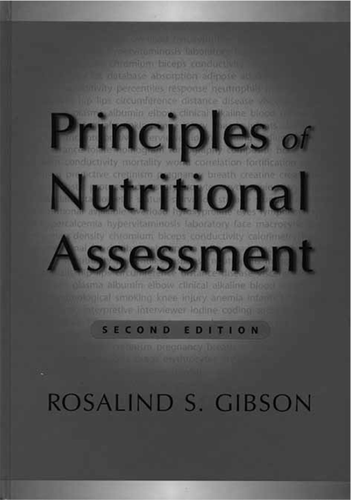Rosalind S. Gibson. 2nd edn. Oxford: Oxford University Press; 2005. 908 pp.ISBN 0-19517169-3. £85.
Rosalind Gibson's standard work, “Principles of nutritional assessment”, is now back in print to the satisfaction of many within the fields of dietetics and nutrition. The revised version encompasses, as did the first edition, a lot of comprehensive information around different methods of assessing nutritional status. Within Scandinavia no similar comprehensive book exists and none other that we know of written in English. Gibson's book is therefore a very useful teaching and reference book for both practising dietitians and those who conduct research within food and nutrition.
Rosalind Gibson is a professor in Human Nutrition at the Department of Human Nutrition, University of Otaga, Dunedin, New Zealand (http://nutrition.otago.nz). Her special interests are trace elements and methods of nutritional assessment. The book is written for an international audience, and for example gives reference data from different parts of the world. The preface notes that the target groups are primarily health professionals in nutritional sciences, home economics, sports nutrition, nursing, medicine and public health. It is an impressive work by a single author. The book gives a thorough and well-covered introduction to the whole area of nutritional assessment, with information about dietary, laboratory, anthropometric and clinical methods and studies.
The new edition has been thoroughly revised. The structure is familiar, which is an advantage to teachers who use it as a course book. Apart from the section about trace elements, which is divided into two separate chapters, the arrangement is the same. Our major comments on the revision refer to the first parts covering dietary assessment methods.
The introductory chapter highlights several important aspects including validity and reliability questions concerning the evaluation and monitoring of individual or group nutritional status using different data collection methods. The problem with using databases for calculating nutrient intake is thoroughly covered and there are references to several international databases. A separate chapter covers measurement error as well as reproducibility in dietary assessment. The chapter that specifically covers the importance of and the difficulty with validation of dietary assessment methods has been updated, especially concerning biomarkers and food intake. For example, recent studies on the fatty acids 15:0 and 17:0 and their relation to milk fat intake are well presented.
The chapter “Evaluation of nutrient intakes and diets” has been suitably updated with regard to the evaluation and reporting of nutrient intake in relation to nutritional recommendations and reference intakes, concerning data on both individuals and groups. Current concepts such as healthy diet indicators and dietary quality index are discussed in relation to food-based dietary guidelines. This is a chapter that should be read by all who report on dietary assessments.
The recent Sixth International Conference on Dietary Assessment Methods in Copenhagen is evidence that the subject is a well-established research area with great international interest. About 500 participants from more than 50 countries took part. The textbook “Principles of nutritional assessment” gives the most comprehensive facts within this field of knowledge, in a thorough manner.
